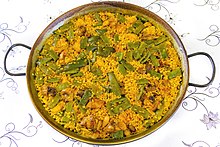
Back باييا Arabic باييا ARZ Paella BCL Паеля Bulgarian Paella d'arròs Catalan Paella Czech Paëla Welsh Paella Danish Paella German Παέγια Greek
 Valencian paella | |
| Course | Main course |
|---|---|
| Place of origin | Spain |
| Region or state | Valencia |
| Associated cuisine | Valencian cuisine, Spanish cuisine |
| Serving temperature | warm |
| Main ingredients | Short-grain rice, chicken, rabbit, vegetables, green beans, garrofons, saffron |
| Similar dishes | Paelya (in Philippines), Fideuà |
Paella (/paɪˈɛlə/,[1] /pɑːˈeɪjə/,[2] py-EL-ə, pah-AY-yə, Valencian: [paˈeʎa]; Spanish: [paˈeʝa]) is a rice dish originally from the Valencian Community. Paella is regarded as one of the community's identifying symbols.[3][4] It is one of the best-known dishes in Spanish cuisine.
The dish takes its name from the wide, shallow traditional pan used to cook the dish on an open fire, paella being the word for a frying pan in Valencian language. As a dish, it may have ancient roots, but in its modern form, it is traced back to the mid-19th century, in the rural area around the Albufera lagoon adjacent to the city of Valencia, on the Mediterranean coast of Spain.[5]
Paella valenciana is the traditional paella of the Valencia region, believed to be the original recipe,[6] and consists of round-grain rice,[7] bajoqueta and tavella (varieties of green beans), rabbit, chicken, sometimes duck, and garrofó (a variety of lima or butter bean), cooked in olive oil and chicken broth.[8][9] The dish is sometimes seasoned with whole rosemary branches. Traditionally, the yellow color comes from saffron, but turmeric and Calendula can be used as substitutes. Artichoke hearts and stems may be used as seasonal ingredients. Most paella cooks use bomba rice, but a cultivar known as senia is also used in the Valencia region.[10]
Paella de marisco (seafood paella) replaces meat with seafood and omits beans and green vegetables, while paella mixta (mixed paella) combines meat from livestock, seafood, vegetables, and sometimes beans, with the traditional rice.
Other popular local variations of paella are cooked throughout the Mediterranean area, the rest of Spain, and internationally.
- ^ "paella". Lexico UK English Dictionary. Oxford University Press. Archived from the original on 22 March 2020.
- ^ "paella". Merriam-Webster's Collegiate Dictionary. Merriam-Webster, Inc. Retrieved 16 January 2022.
- ^ Canela, Joan (24 September 2023). "La paella com a símbol d'identitat però també d'acollida". La Veu del País Valencià (in Catalan). Retrieved 2 March 2024.
... la paella és segurament el principal tret identitari que uneix (o no) els habitants d'aquest raconet del món entre el Sénia i el Segura.
[... paella is probably the main identity trait that unites (or not) the inhabitants of this corner of the world between the Cenia and Segura [rivers]. (i.e. Valencians)] - ^ Panadero, Amparo (11 March 2019). "La paella valenciana quiere ser Patrimonio de la Humanidad". Diario16 (in Spanish). Retrieved 19 February 2020.
En el caso de la paella valenciana, se trata de una tradición culinaria y social que constituye un icono de hospitalidad y un símbolo de unión e identidad valencianas ...
- ^ "Info about Paella on About.com". Spanishfood.about.com. 15 December 2009. Retrieved 19 February 2010.
- ^ Saveur, "The Art of Paella" (accessed 21 July 2015)
- ^ Paella Rice (accessed 12 April 2020)
- ^ Phaseolus lunatus L. var. macrocarpus Benth.
- ^ "La Bible de la Paella: The Garrofon". Archived from the original on 5 September 2018. Retrieved 5 September 2018.
- ^ "Senia Rice". Retrieved 27 August 2021.
© MMXXIII Rich X Search. We shall prevail. All rights reserved. Rich X Search